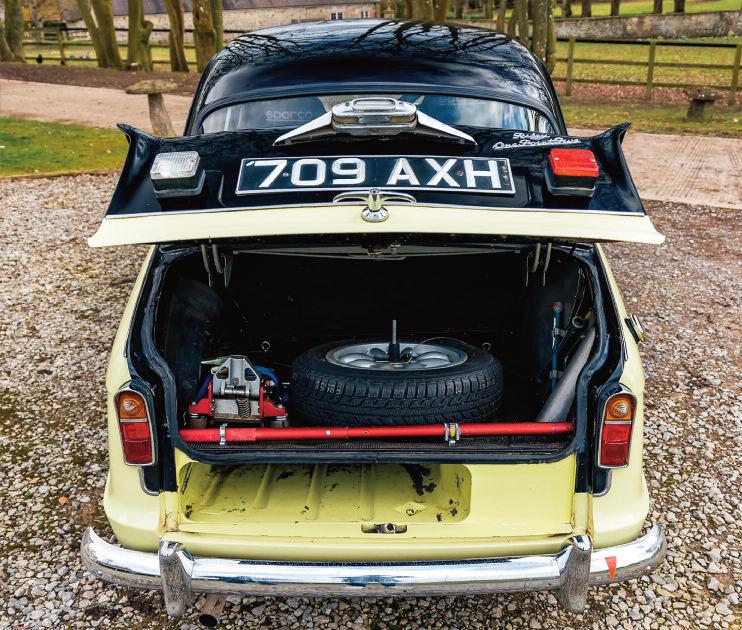
C L A S S I C C A R S

Cover illustrations
Front: lot 37
Inside front: lot 20
Inside back: lot 22
Back: lot 39



C L A S S I C C A R S

Cover illustrations
Front: lot 37
Inside front: lot 20
Inside back: lot 22
Back: lot 39

Saturday 22 June 2024
2pm Lots 1-46
Head of Sale
Nick Wells
nick.wells@doreandrees.com 01373 462257 / 07920 500091
Enquiries enquiries@doreandrees com
Viewing
See page 4 for details
Catalogue
£10 (including p&p)
Dore & Rees
Auction Salerooms
Vicarage Street
Frome BA11 1PU 01373 462257 www.doresandrees.com



The following notes will give you the most important information regarding how to bid and buy.
Please keep an eye on the auction catalogue listed at auctions.doreandrees.com/auctions/ where any specific arrangements for auctions will be kept updated
The full Terms and Conditions of Sale can be found at doreandrees com (link at the bottom of the webpage) and also printed at the back of this catalogue
Dore & Rees do our best to ensure vehicles presented for auction are fairly and accurately described Classic cars are by their definition collector's items and not intended to be sold in the same way as a modern car from a retail dealership As such we would advise buyers to satisfy themselves as to a Lot's condition before bidding
Condition reports will be available up to 48 hours before the auction, requests are to be submitted via the lot details page of the auction catalogue listed at doreandrees com/upcoming-auctions
Deposits may be requested for high value lots in advance of the auction. Deposits can be paid by debit card or BACS payment and will be refunded in the event that you are not the Buyer of the lot.
Registration closes at 5pm on the day before the auction. New bidders are requested to provide the following:
• Name, address, telephone number and email
• Two forms of identification
- A passport or photographic driving license
- A utility bill or document showing proof of name and address
When registering to bid online via doreandrees.com or via easyliveauction.com, you will be requested to provide your bank or credit card details to complete 3D secure authentication
In person – join us in the saleroom By absentee bids – you can submit your absentee bids via doreandrees com By telephone – a limited number of telephone lines will be available for the auction, bookable on a first come first serve basis
Online – bid live online via doreandrees.com, easyliveauction com and the-saleroom com, charges apply.
As a Buyer, you will pay the Hammer Price, Buyer’s Premium of 12% of the Hammer Price (inclusive of VAT) of cars, any artists resale right royalty payable on the sale of the Lot and any further VAT due. For motor cycles, Buyer’s Premium is 15% (inclusive of VAT), indicated by ‡ alongside the lot number
Additional charges apply to online bidding.
Purchases can be paid by BACS, Debit Card, or Cash (up to a limit of £8,000 in person) Payment is due within 5 working days of the auction.
All cars are to be collected after the auction, up to 6pm on Saturday 22 June or between 9am and 1pm on Sunday 23 June
Lots that cannot be collected from the auction site by 1pm on Sunday 23 June will be taken into secure storage at the buyer’s expense
Costs are as follows:
Transport - £150 + VAT
Storage - £14 per day for the first 14 days, £10 + VAT per day thereafter
Storage details:
Rudler Car Transportation and Storage
P O Box 11, Royal Wootton Bassett, Swindon, Wiltshire, SN4 7SY
Tel: +44 (0)1793 73 11 07
A very warm (we hope!) welcome to The Summer Auction with Dore & Rees
Our forthcoming sale covers a range of collector's cars of all eras and uses, from pre-war commercial vehicles to musclebound V8 sportscars and midengined modern supercars
A highlight is the truly wonderful 1974 Series III Jensen Interceptor, supplied new by our vendor's father in 1974, owned by the family for decades, never driven in the rain and never offered for public sale, until now A rare find in such beautifully preserved condition, we're thrilled to have it in the sale.
We have a brace of modern Ferraris; the 348 is becoming ever more collectible for its baby-Testarossa looks, nimble handling and good value The 360, now a 25-yearold design itself, is also quickly finding classic status in the market Or for oldschool charm and class, the 1934 Bentley 3 ½ Litre All-Weather Tourer by Barker, a supremely rare and handsome machine which is well travelled in recent years.
If you're more into the rustic charm of a classic commercial, there's a too-cute-tobe-true 1933 Austin Seven C Cab van on offer, with just about enough load carrying capacity for the weekly shop You can also choose from a classic Land Rover or Toyota off-roader, or maybe the French

Nick Wells
farmer's egg carrier of choice, the 2CV 'Fourgonette'?
All of the above are spliced into our usual mix of fun classics, sportscars, GTs and sporting saloons, and this time a collection of 1950s Italian motorbikes On view by the Cheese & Grain building in Frome on Friday 21st, and Saturday 22nd June Best

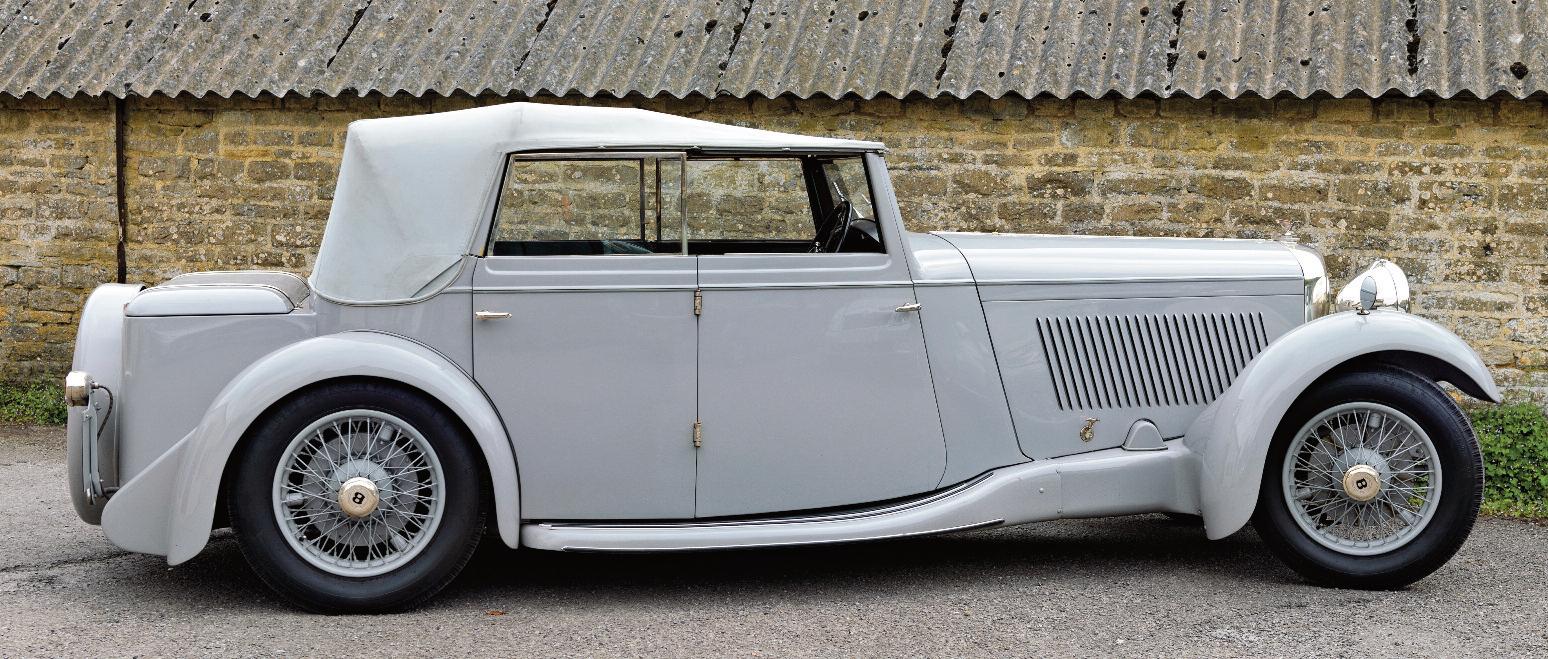
Friday 21 June 10am to 6pm
Saturday 22 June 89am to 2pm
Viewing will be held at the Cattle Market car park, next to the Cheese and Grain, Market Yard, Frome BA11 1BE (see on map)
1

All auctions are held at Dore & Rees Auction Salerooms, centrally located in Frome, Somerset, approx 10 minute walk from the station with direct trains from London Paddington, operated by Great Western Railways
Dore and Rees
Auction Salerooms Vicarage Road
Frome BA11 1PU 01373 462 257

Saturday 22 June 2024 at 2pm
1
c 1963 Capriolo 125
● Unfinished project with much of the hard work done
In 1947 Aero-Caproni turned to motorcycle production, beginning with a 48cc ‘ciclomotore’ two-stroke. They also built frames for Ducati’s “Cucciolo T3” and “Ducati 60” By 1951 they were producing sophisticated and elegant little four speed 75cc four strokes with pressed steel chassis, later enlarged to 100cc and 125cc Their more interesting machines included a horizontally opposed 149cc twin of 1955, and competition machines with 75cc engines using the Küchen desmodromic system of the 1920s
From 1953 to 1959 they also produced NSU engined machines named Caproni-Vizzola with models named Cavilux and Cavimax, the latter based on the NSU Max engine At one time the range also included a face-cam OHV single, and they also built a range of threewheelers In 1958 the Capriolo company name was changed to Aeromere, which ceased production in 1964 The motorcycle business was sold to Laverda
The parent company, Aero-Caproni, continued to build aircraft, some of which were very advanced Their jetpowered glider remains one of the most extraordinary sailplanes ever constructed
This Capriolo 125 has been dismantled, and the individual components restored before the sad passing of the vendor Offered from the estate of a local collector, the bike comes without documentation or keys, is not currently UK registered and so will be sold on a bill of sale
£500-£1000


Frame Number: 62448
Engine Number: 62443
Recorded Mileage: N/A

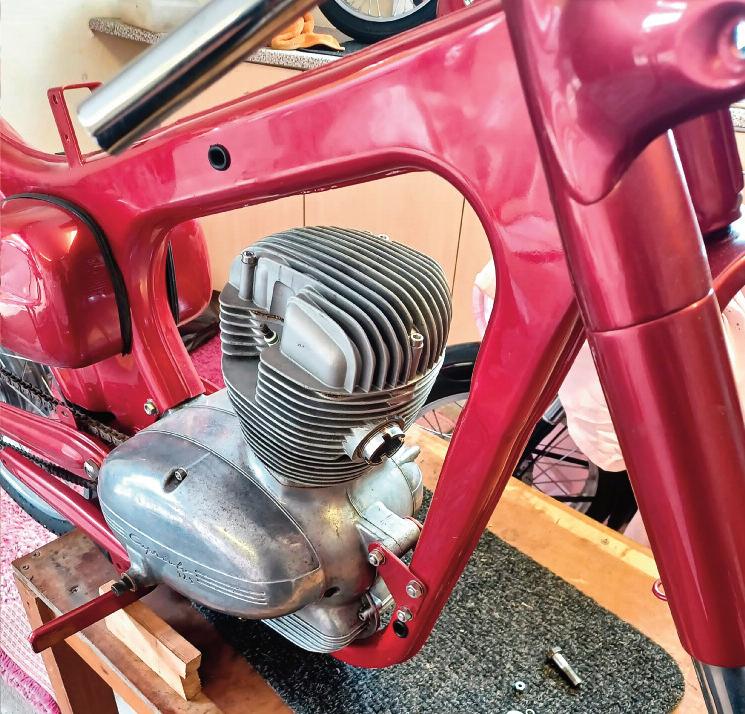

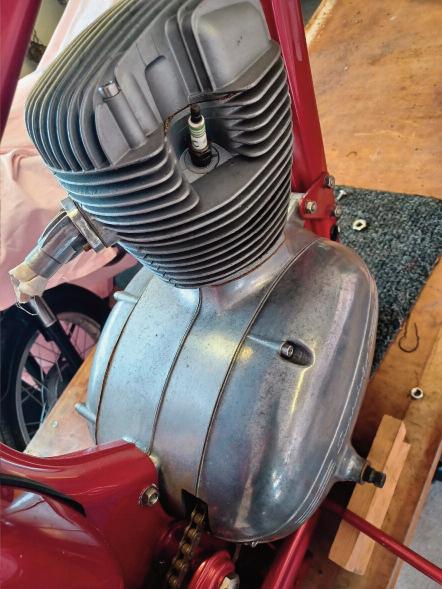
c 1952 Gilera 150 Tourismo
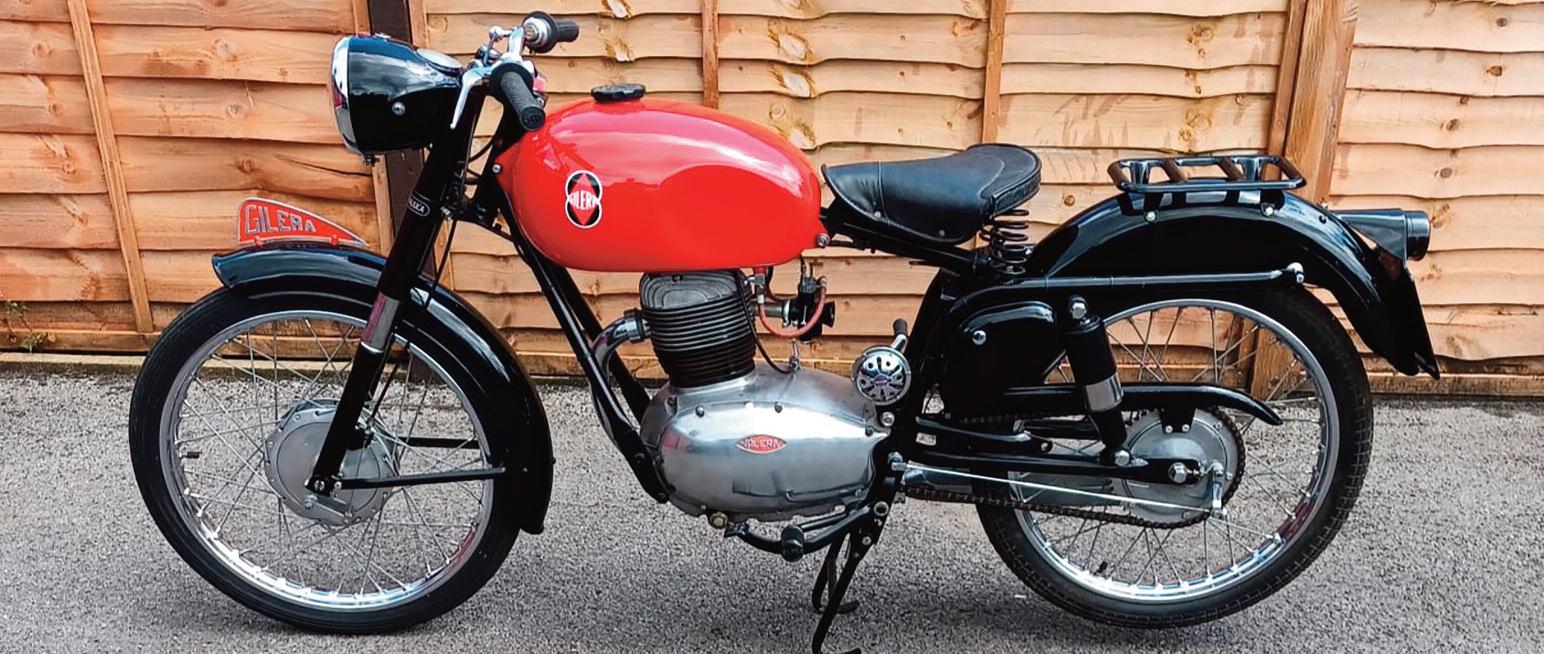
In the early 50s, new regulations in Italy allowed access to motorways for motorcycles with a minimum capacity of 150cc, so Gilera upgraded its 125 to 150cc The 150 presented in 1952 became Gilera’s best selling motorcycle, ever with 96,000 units produced The 150 was what the public wanted, and Gilera responded with the introduction of the Gran Turismo in 1955, followed by the Super Sport and Super Red in 1957
This lovely example was lovingly restored by an Italian bike specialist but never used on the road, having being kept in a private collection Having not run for some
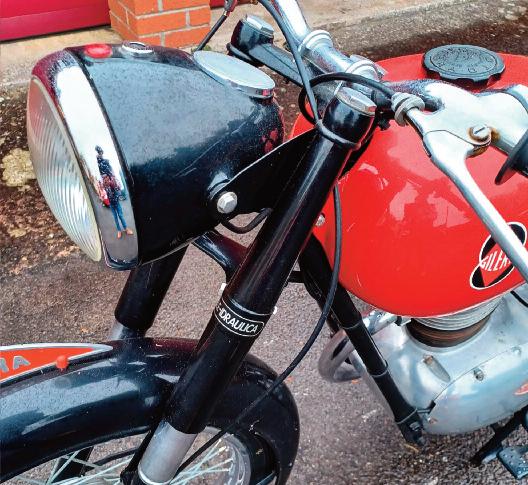
Frame Number: 4234
Engine Number: 19-1557
Recorded Mileage: TBA
years, the bike will require light commissioning Offered from the estate of a local collector, the bike comes without documentation or keys, is not currently UK registered and so will be sold on a bill of sale
£1000-£1500
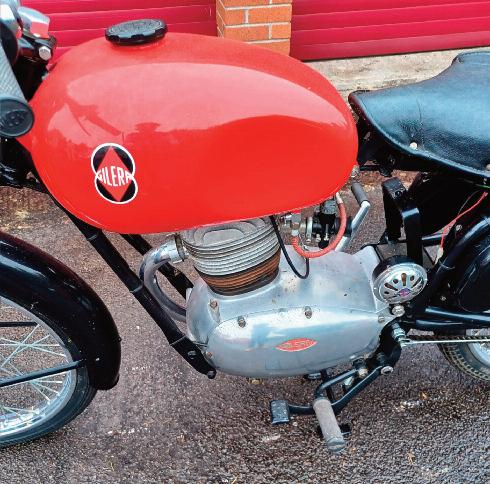



The Gilera Sei Giorni Speciale (Six Days Special) was built to celebrate Gilera’s success in the International Six Days Trial, a grueling trail/road event that only the strongest survived In 1964 Steve McQueen substantially funded an American team that would take part in the International Six Days Trial, McQueen would ride himself, with some success on a Triumph.
The Sei Giorni sported a 124cc OHV 9hp single cylinder engine with a claiimed top speed of 72mph The 1961 model was sold in red and white livery, later Speciale models from 1964 being presented in a black and white colour scheme instead


Registration Number: KMM 167B
Frame Number: TBA
Engine Number: TBA
This beautiful Sei Giorni has been lovingly restored by an Italian specialist and done zero miles since restoration, being kept in a private collection Supplied with a key and UK V5C, the machine will require some light commissioning £2000-£3000
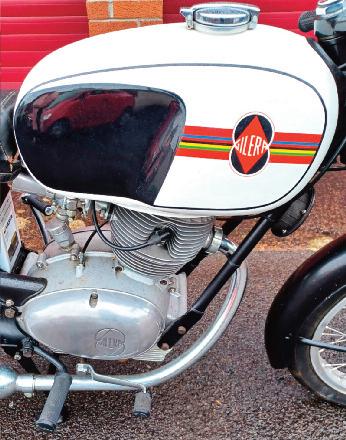



The Airone 250 appeared in 1939, quickly becoming the most popular and versatile Italian 250cc bike on the market The model proved to be suitable for multiple purposes; work, touring and competition Beginning in 1947, the “modern” Airone was born and reached its peak with the 1949 Sports model, fitted with a state-ofthe-art front fork and powerful engine capable of reaching 120 kph This performance allowed Moto Guzzi to rack up wins in the 250cc race class, both in Italy and around the world The Airone 250 remained in production until 1957
This beautiful Airone has been expertly restored by an
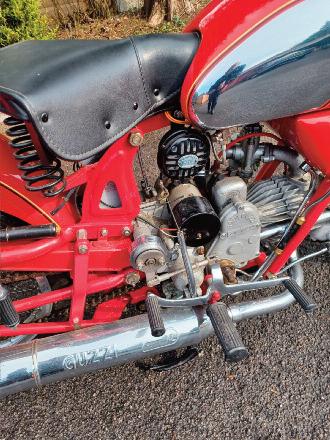
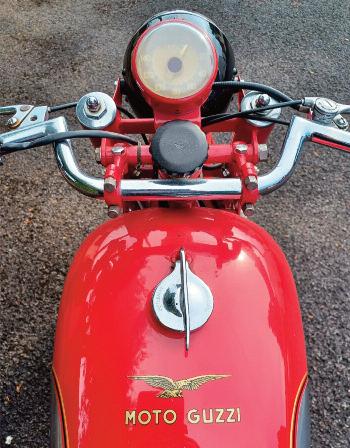
Frame Number: MBT68
Engine Number: 100881/MBT85
Recorded Mileage: N/A
Italian bike specialist, but having not been ridden since will benefit from recommissioning Offered from the estate of a local collector, the bike comes with a dating certificate and HM customs letter, is not currently UK registered and so will be sold on a bill of sale £3000-£5000

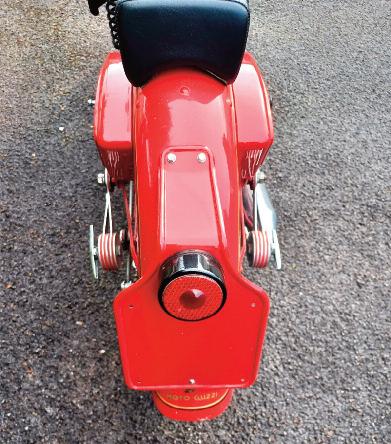


Founded in Bologna in the late 1920s, F B Mondial became known for its successes in Grand Prix motorcycle racing during the 1950s The firm produced some of the most advanced and successful road racers of all time, winning ten rider and manufacturer World Championships between 1949 and 1957. At a time when M V Augusta and Ducati were making affordable lightweight two-stroke machines, mopeds and scooters, Mondial were producing high-quality sporting motorcycles
In 1957, Soichiro Honda approached Mondial owner Count Boselli to buy the Mondial race bikes (which had just won the 125cc and 250cc world titles); the original Mondial 125 race bike is still on display at Honda’s Motegi museum in Japan The Turismo Veloce was designed for fast sport touring and had remarkable

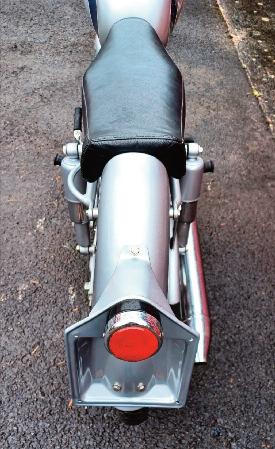

Frame Number: 02375
Engine Number: 02375
Recorded Mileage: TBA
build quality with unmistakable style, inspired by the bikes that had won laurels throughout the racing world
This beautiful Turismo Veloce has been expertly restored by an Italian bike specialist, having not been ridden since Offered from the estate of a local collector, the bike comes without documentation or keys, is not currently UK registered and so will be sold on a bill of sale
£4500-£5500

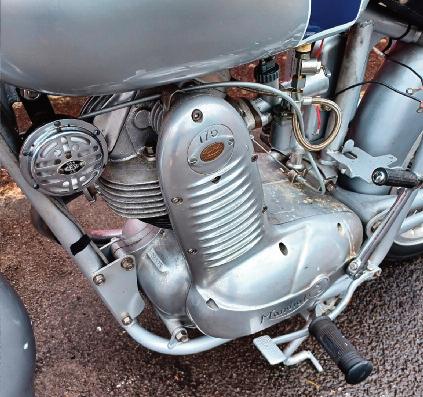


1959 Moto Guzzi Zigolo
● UK registered with original buff log book

Produced in the original Moto Guzzi plant from 1953 to 1966, the Zigolo Turismo, one of the first motorcycles to sport fully enclosed bodywork, was powered by a two-stroke single-cylinder 98cc engine that exerted a staggering power of almost 4bhp! The Zigolo was designed to be a low cost step up from the company’s original two-stroke, the 65cc Guzzino Over 130,000 Zigolo scooters were manufactured in its 13 year production run,
The lovely restored Zigolo was restored by an Italian


Registration Number: 87 GHU
Frame Number: VG156
Engine Number: V9156
motorcycle specialist, and now offered with a V5C, buff logbook, owners handbook, also service and parts manuals
£900-£1200




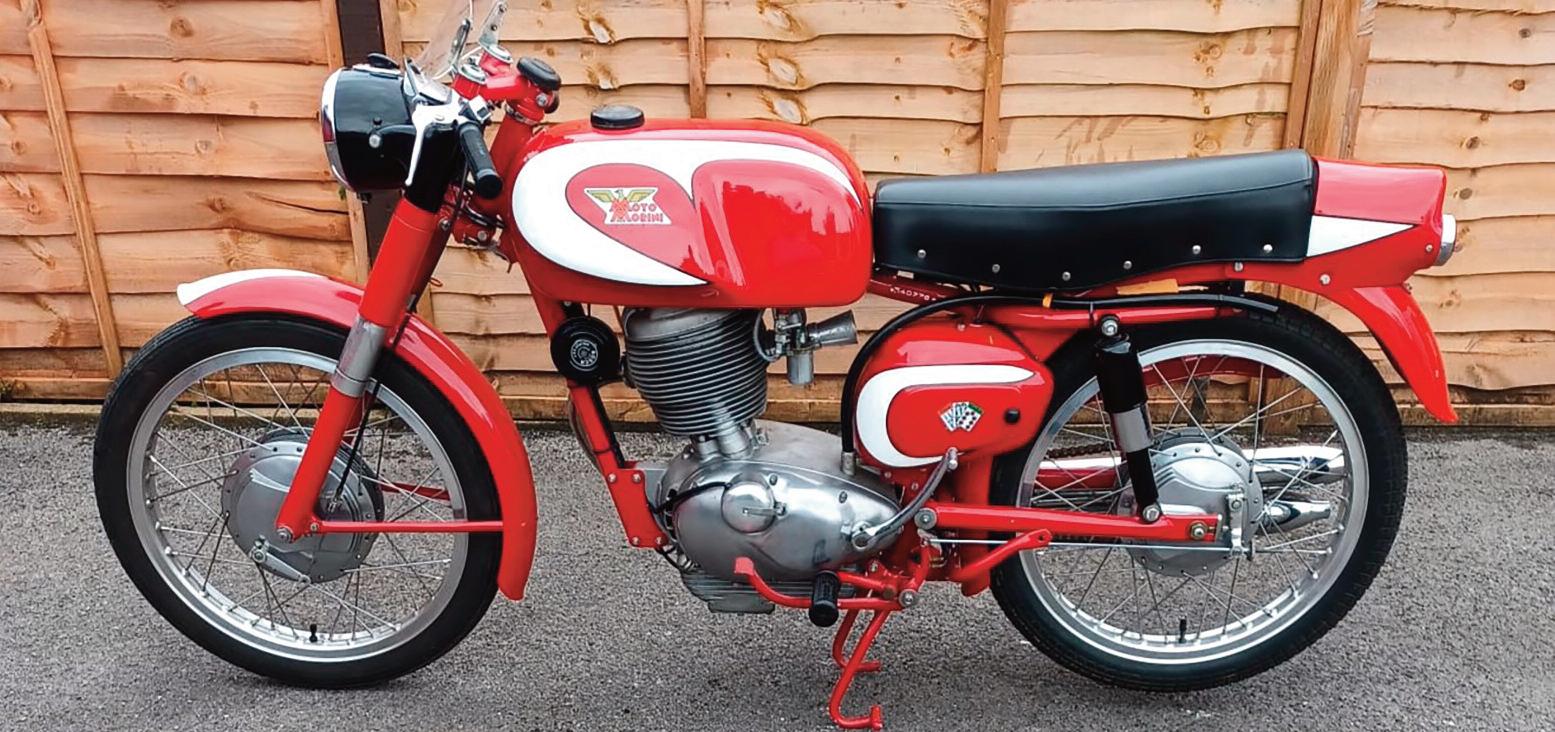
Founded in 1937, Moto Morini initially built two-stroke lightweights before developing a range of fast fourstroke roadsters during the 1950s. The Tressette was the last in the line of singles, named after popular Italian card games; earlier machines being Settebello (Beautiful 7) and Briscola (Trumps) The Tresette (Three 7s) produced a respectable 10hp from its single cylinder engine The pinnacle of development was the Tresette Sprint with higher compression and a sports carburettor to increase the power to 13bhp and a top speed of 130kph Most Tresette’s had an attractive small fly screen and dropped handlebars, proving popular in contemporary Italian “Moto Giro “ events
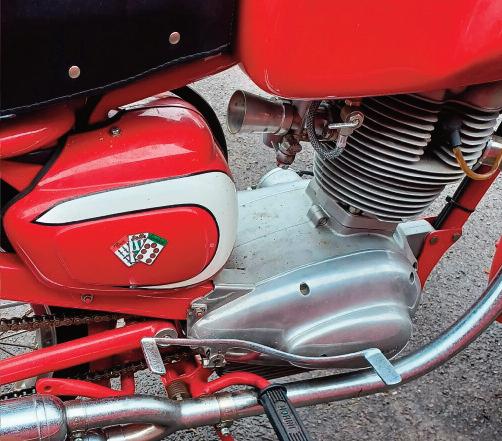

Frame Number: TS40776
Engine Number: TS40776
Recorded Mileage: TBA
This beautiful 1958 Tresette Sprint was lovingly restored by an Italian bike specialist and has completed zero miles since restoration. Offered from the estate of a local collector, the bike comes without documentation or keys, is not currently UK registered and so will be sold on a bill of sale
£4000-£5000
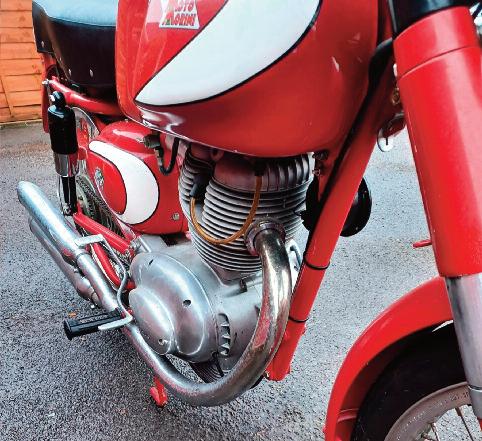



● Just 3 delivery miles from new ● UK registered with current V5C
“The MV Agusta Brutale 910 is the mother of all Sunday bikes – expensive, impractical, temperamental and utterly brilliant ” Motorcycle News, November 2006
Conceived by designer Massimo Tamburini, MV Agusta’s Brutale range were launched in 2001 as a naked bike powered by a series of either inline-three or -four DOHC engines in various capacities
Derived from the 1990–1992 Ferrari Formula One engine, and with the assistance of Ferrari engineers in the engine’s development, the new units were liquid cooled with two overhead camshafts (DOHC), 16 ‘radial’ valves, electronic multipoint fuel injection, and induction discharge electronic ignition. The engine is unique in the sense that it is the only recently produced radialvalved motorcycle engine A new chassis was created under the leadership of Technical Director Massimo Parent The engine hangs from a tubular frame and is a stressed member The wheels and swinging arm are made of aluminium, as are the frame plates and the fork bridges.
The first model was introduced in 2001; the MV Agusta Brutale 750 Oro, using many magnesium parts and limited to 300 machines. This was followed in 2002 by the MV Agusta Brutale 750 S, and from 2005 the 910cc engined 910S. The new engine produced 136 bhp at 11,000 rpm, powering the bike until the next redesign in 2010
This extraordinary example can best be described as being in as-new condition A 2006 model, the 910S was


Registration Number: WX70 HZC
Frame Number: ZCGF411AC6V006440
Recorded Mileage: 3 miles

not first road registered until 2020, and yet still has a mere 3 miles recorded from new As yet never used on public roads, with a current V5C and all owner’s documentation, this collector’s grade example will make the ideal addition for a serious motorcycle collection.
£8000-£12000

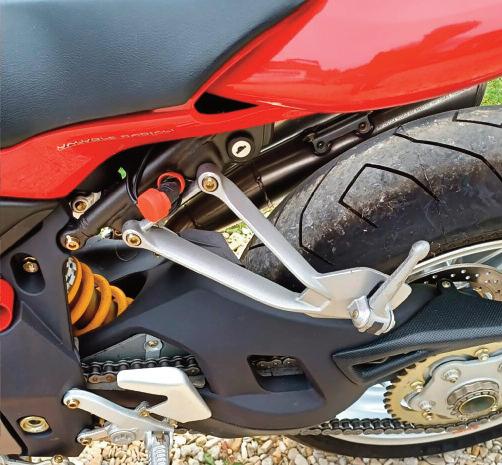
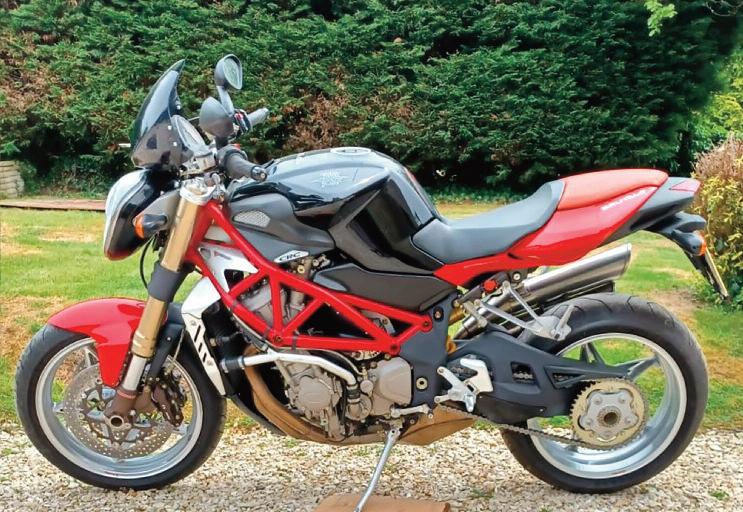

1974 Fiat 500 R
● Recently recommissioned
● As used on The Trial of Christine Keeler
At Fiat, the approval of the new model 126 was preceded by a long debate on the real opportunity for a radical replacement of the 500 rather than a simple update In any case it was immediately obvious that the mechanics, robust and economical , remained unchanged Also on the basis of the first “safety” requests of the cars, the end was chosen for the launch of a new model; however the still substantial success of the 500 did not immediately diminish but allowed a phasing in for another three years in the Fiat range
At the Turin Motor Show, in November 1972, the Fiat 126 was presented as well as the last series of the 500: the R (“Renewed”) or, as it was also initially called, “unified” The engine that equipped both cars was a 594cc unit The new engine in the 500 R delivered a maximum power of 18hp with a Weber 24 carburettor, allowing the 500 R to hit the 100kph threshold on the open road The public then seemed to prefer the 126 and so the extraordinary adventure of the 500 ended 1st August 1975
Formerly part of a large and prestigious collection for many years, more recently the little Fiat has been owned by a local Italian car enthusiast, being recommissioned with a new fuel tank, fuel pump, battery, electronic ignition and new leads/distributor cap, headlamp bezels, and used purely for fun local trips and film work. The Fiat recently had a cameo role in the BBC drama, The Trial of Christine Keeler
The Fiat will be sold with a current V5C and new MOT certificate, and original jack.
£4000-£5000

Registration Number: KPW 804N
Chassis Number: 5193899
Recorded Mileage: c 25,000 kms
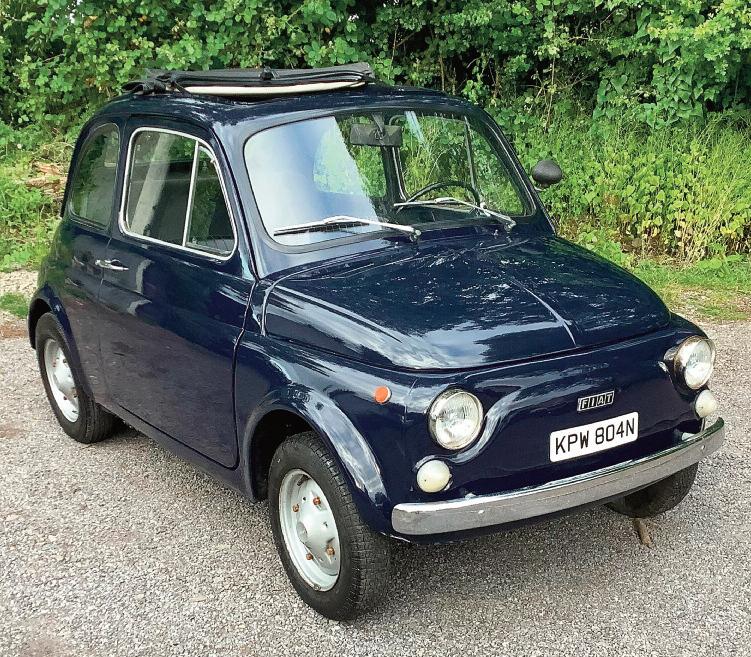


1972 Fiat 500 Abarth Tribute
● Fresh from recent restoration
● Many improvements from standard

‘The performance of FIAT engines, as modified by Carlo Abarth, has for long been held to verge on the supernatural ’ – John Bolster, Autosport Magazine
With their FIAT 500-based 595, Abarth adopted the most cost-effective method of coaxing greater power from a small engine, a new big-bore cylinder block boosting the previously 499cc air-cooled twin to 593cc Higher-compression pistons, re-worked inlet ports, a special camshaft and exhaust system, and a larger carburettor helped raise power from 22 to 30bhp, though the biggest gain was in mid-range torque Abarth’s conversion halved the standard car’s acceleration times and endowed the 595 with a top speed of more than 75mph Lowered suspension and wider wheels and tyres helped the baby FIAT utilise the increased performance Those still not satisfied could opt for the 595SS (Sprint Speciale), with 34bhp on tap and an 80mph top speed And if that wasn’t enough, there was a further stretch available: to 695cc in the form of the formidable 695SS
This super 500 was restored in Italy to the specification of the current owner, an enthusiast of Fiat 500s and other interesting classic city cars The restoration was detailed, including a full strip of the bodywork followed by any repairs as required, and then finished in brilliant white
The engine was replaced by a newly rebuilt and more powerful 650cc unit mated to an all-synchro gearbox. The braking system was replaced throughout, as were cables, all rubber seals, and the wiring loom. The seats


Registration Number: FHH 453K
Chassis Number: TBA
Recorded Mileage: 6,800 miles
were treated to a retrim and new carpets fitted To complete the look the suspension has been lowered and placed on new Abarth alloy wheels with new tyres, the roof recovered in red vinyl, bumpersremoved and an Abarth wooden steering wheel fitted.
With attitude in spades, this charming little devil is ready (and very eager) to tear up the streets once more!
£8000-£10000
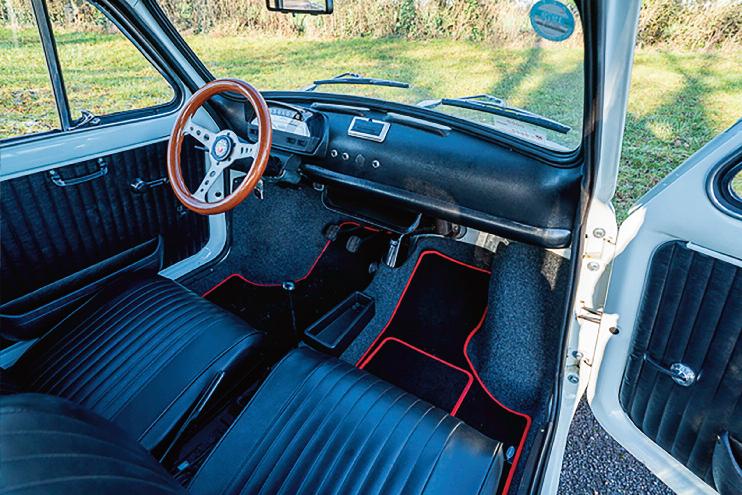


Launched in 1959, and considered an icon of the 1960s, the Mini is one of the most successful motor cars of all time, and one which transcends class and social status with consummate ease Such was the success of the Mini that it was exported to every corner of the world, and indeed manufactured in most continents for local home markets The Italian version of the Mini, sold under the Innocenti marque, was produced in Milan and distributed throughout Europe
Such was the demand for the Mini that a huge variety of limited editions were produced over the years.
Launched in 1991, the Neon was based on the City variant of that model year The “Neon” was originally meant to be produced in Caribbean Blue Pearlecent, but problems with the new paint meant that the production version was made in Nordic Blue. The Neon featured chrome bumpers and door handles, grille surround and exhaust tailpipe. The exterior was finished with “Neon by Mini” decals, and the interior was treated to chevron velour with a Neon badge on the steering wheel 1500 were produced in total
This Neon was previously acquired by an enthusiast around 6 years ago, who we understand invested over £4,000 on refurbishing the car, including a repaint in the orginal colour
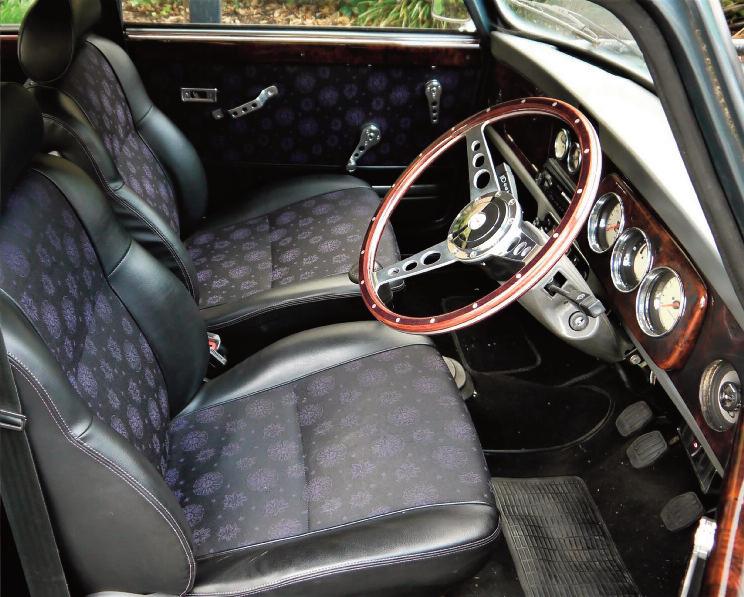
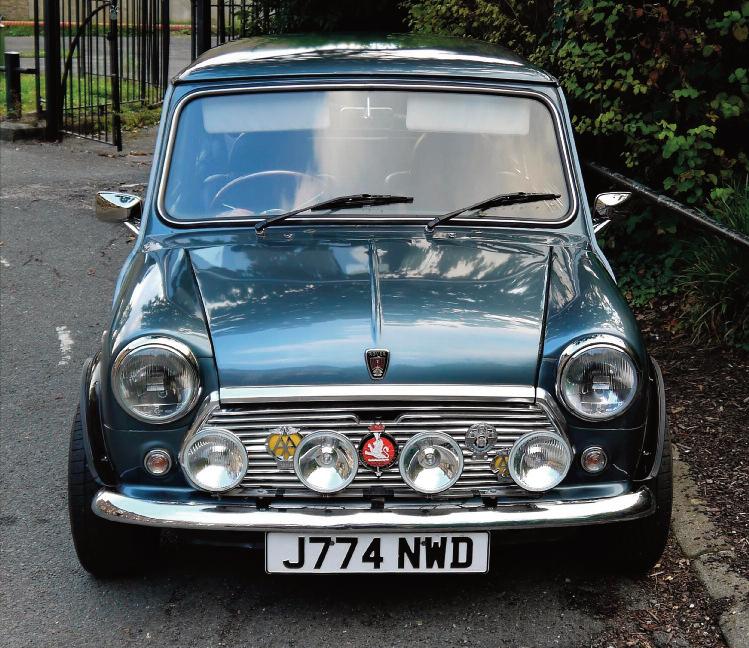
Registration Number: J774 NWD
Recorded Mileage: 58,500 miles
Chassis Number: TBA

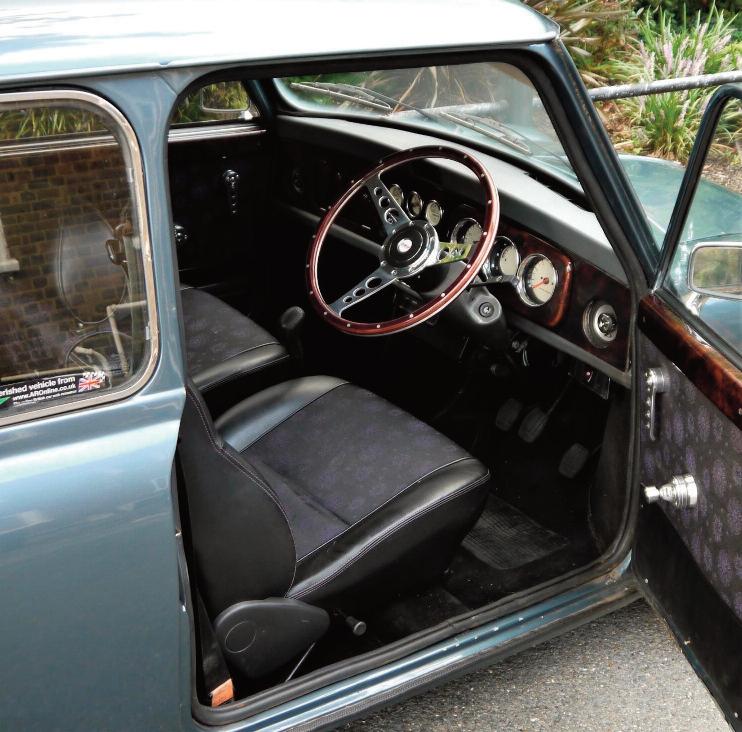


The subsequent keep owned the Mini for around 2 years, during which time the interior was replaced with full Mini Equinox trim, as was carpeting and weather seals. The suspension has been upgraded with adjustable shocks and four-spoke Revolution wheels sitting in wider arches, and treated to a row of rally spotlights to the front
In current ownership since 2021, the Mini has be subject of a number of further works. Professional repairs were carried out to the floor, subframe and chassis mountings The Mini was treated to a partial respray, the clutch hydrulics have been overhauled,


new plugs fiitted, the car tuned, and minor electical issues attended to Invoices for over £4,000 support this work
The Mini is offered with a V5C, current MoT certificate and file of bills for previous maintenance works £5000-£6000


● In current ownership for approximately 50 years
● Subject to previous comprehensive restoration

Designed by Alex Issigonis in 1959, a new concept in car design was born With a monocoque shell, transversely mounted engine and front wheel drive, the new ‘Mini’, soon became popular across a broad spectrum of the population The potential for competition use was soon seen by John Cooper; BMC were finally persuaded by John Cooper and the two worked together in culminating the birth of the Austin Mini Cooper and the Morris Mini Cooper in 1961 Victories in the 1964, 1965 and 1967 Monte-Carlo Rallies set the Mini on the road to fame but probably the greatest publicity was gained from their, somewhat

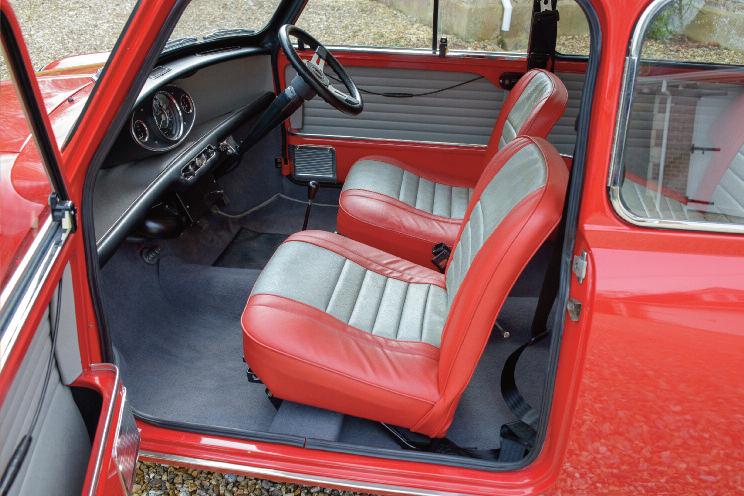

Registration Number: EOV 77D
Chassis Number: See description
Recorded Mileage: 75,550 miles
unfair, disqualification for lighting irregularities in the 1966 event after coming in 1st, 2nd and 3rd A more powerful Mini Cooper, dubbed the ‘S’, was developed in tandem and released in 1963
Remarkably this Mini Cooper Mark 1 1275 ‘S’, a 1966 model with Hydrolastic suspension, has been in single
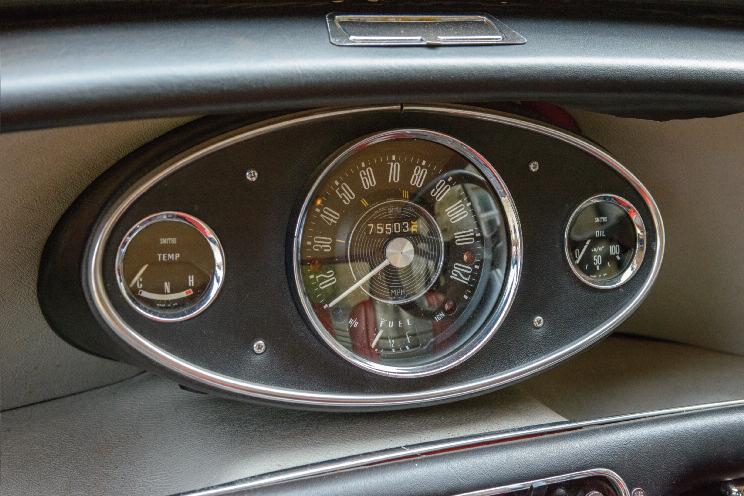
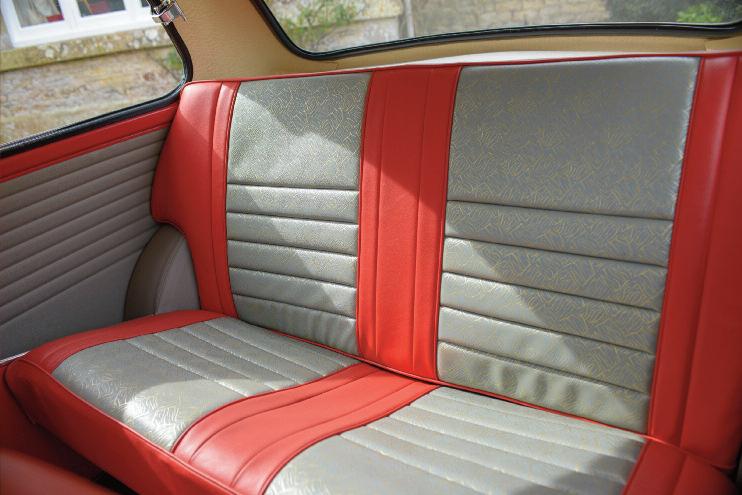
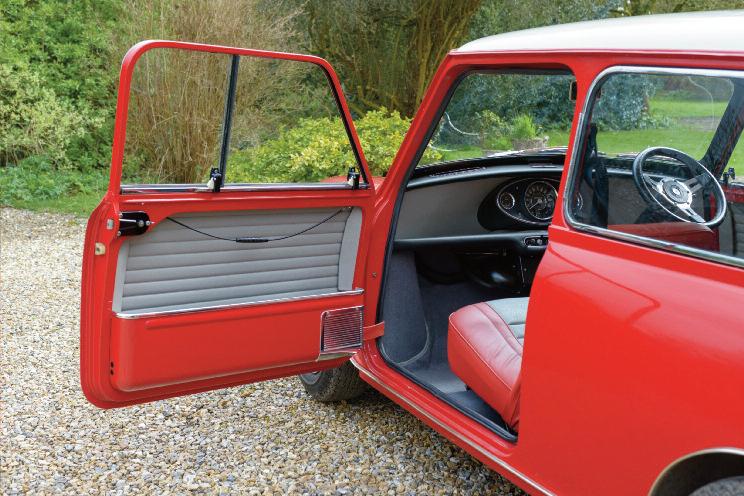
ownership since around 1974. After enjoying the Cooper for daily transport over a few years, in the late 1970s our vendor placed the car into a lean-to garage awaiting restoration The conditions over the years had not been kind to the Mini, unfortunately it deteriorated rapidly to the extent that by the time restoration was viable, the original shell was sadly beyond repair A period-correct donor shell was acquired, and the restoration began in earnest
Between 1990 and 1991 the replacement shell was prepared and painted, and the car’s original mechanical and trim components transferred across The engine and gearbox were rebuilt, new subframes stove enamelled and fitted, the vehicle retrimmed in original BMC specification materials, and numerous other parts purchased from Minispares of London as required
Originally finished in Old English White with a black roof, EOV 77D is now presented in Tartan Red with a white



roof, with Minilite wheels on each corner Since restoration the Mini has been dry stored, before being recommissioned in 2002, and then again in 2023 prior to this sale. During restoration, the donor shell did however not come with a chassis plate, and sadly the original logbook has been lost some years ago, so potential buyers will need to carry out their own research before applying for a new V5C As such the car will be sold on a bill of sale without a current registration document
Offered with receipts for restoration and other work completed, photographs before and after its restoration, and an MoT certificate from 2002, this super Cooper offers the next enthusiast a wonderful opportunity to acquire one of the icons of the 1960s’ at an eminently sensible price
£14000 - £16000


1971 Austin Sprite Mark IV
● Super rare ‘AAN10’ run-out Sprite model
● Significant £5,000+ expenditure in current ownership
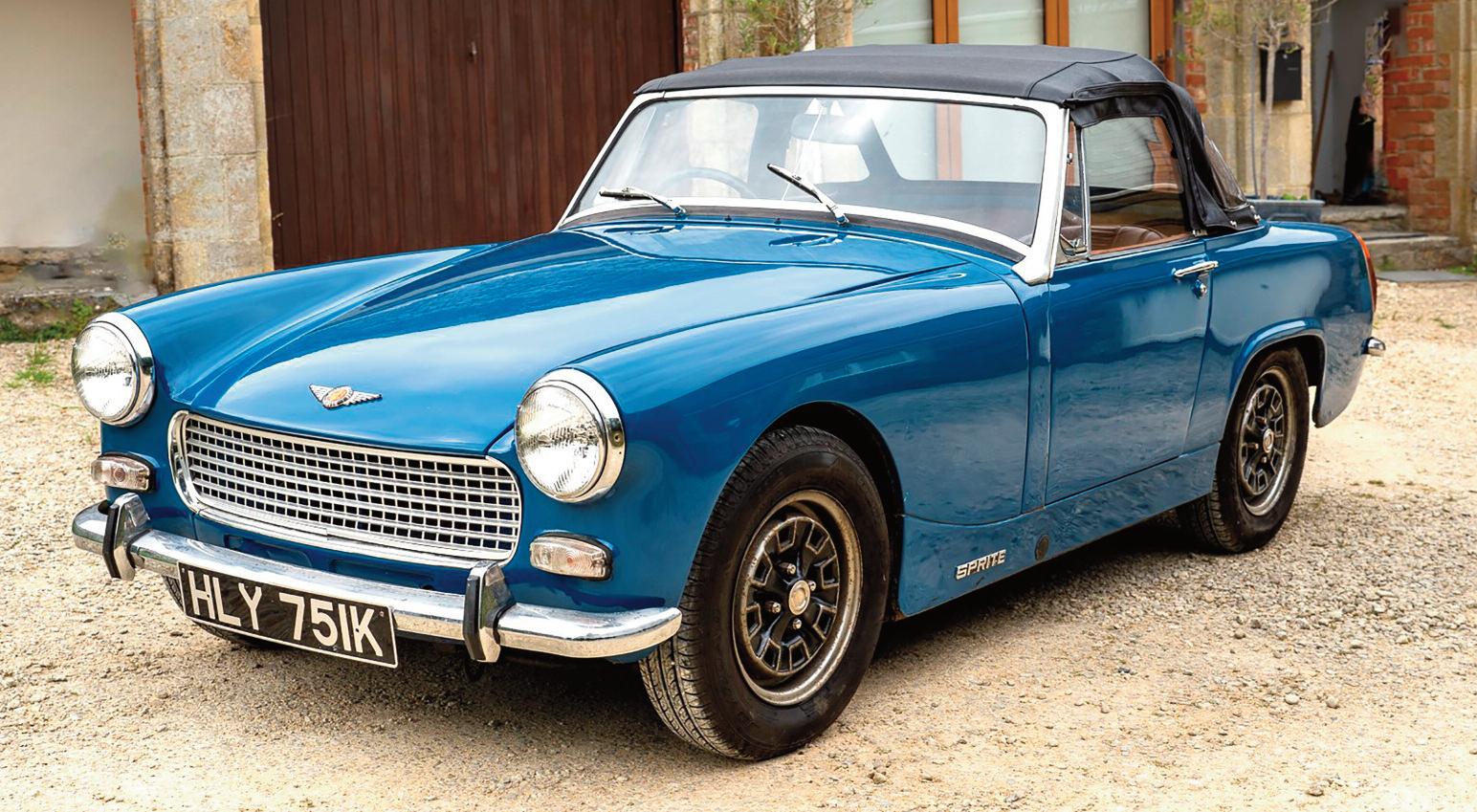
The final iteration of Austin-Healey Sprite arrived in 1966. Engine capacity went up again with a switch to the 1 3-liter engine (1275cc) from the Mini Cooper S, albeit with slightly less power than in the Mini, at 65 hp and 72 lb-ft The convertible top was now fixed to the Sprite’s frame instead of being a removable assembly, and a range of minor changes were made, including the addition of reverse lights and a new hydraulic system for the brakes. By 1970, BMC had been absorbed into British Leyland and changes were made to update the Sprite’s design once again, with more parts shared between the Sprite and the MG Midget The following year, 1971, the Austin/Donald Healey partnership dissolved, and the last 1,000 or so Sprites were simply badged as Austins This was a cost-cutting move of Donald Stokes, enabling British Leyland to stop paying royalties to the Donald Healey Motor Company
There was no direct successor, as British Leyland’s extensive range already contained the MG Midget,

Registration Number: HLY 751K
Chassis Number: AAN10-87537-G
Recorded Mileage: 104,000 miles


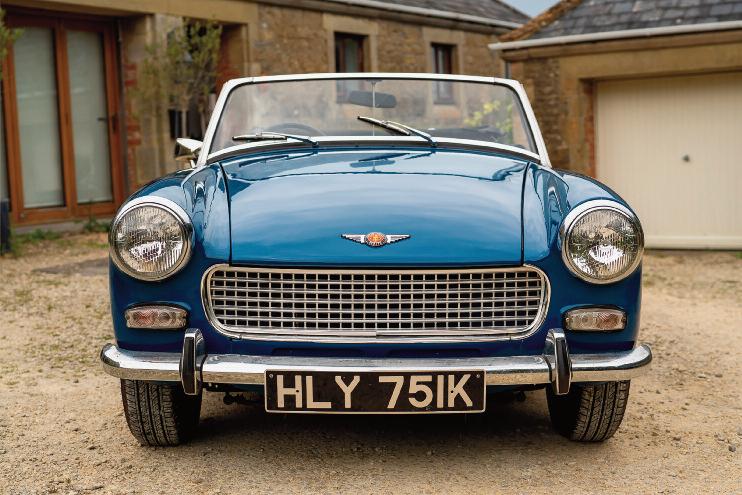
which was identical to the Sprite except for badging, and the similarly dimension and priced Triumph Spitfire
This very late run-out model with the chassis number prefix ‘AAN10’, was first delivered in August of 1971 in the last year of the car’s production One of only 1022 such cars made, and named merely the Austin Sprite, this example was purchased in the early 1990s, garage kept but seldom used due to work commitments, and so was decided to be sold
More recently
the Sprite has joined a small local classic car collection, being lavished with much TLC
When the car arrived it had not been used for some time and was in need of thorough recommissioning The engine and gearbox were pulled, the gearbox rebuilt and refitted with a new clutch and flywheel The engine was painted, various hoses and cooling taps were replaced, the carburettors rebuilt and a high torque starter motor fitted The car was serviced with all fluids, the brakes bled, and the fuel tank/sender replaced Finally a new convertible soft-top has been fitted
Invoices on file for c.£5,000 support the works completed
As you can imagine, with the hard work now completed, this rare Sprite is on the button and ready to be enjoyed!
£4000-£6000
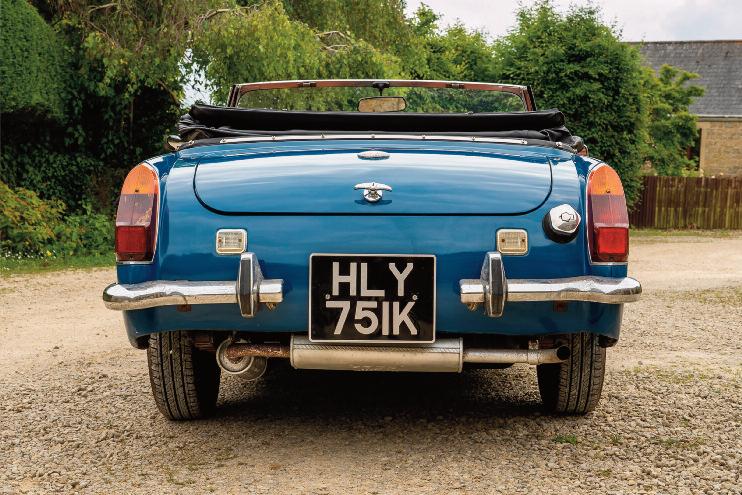


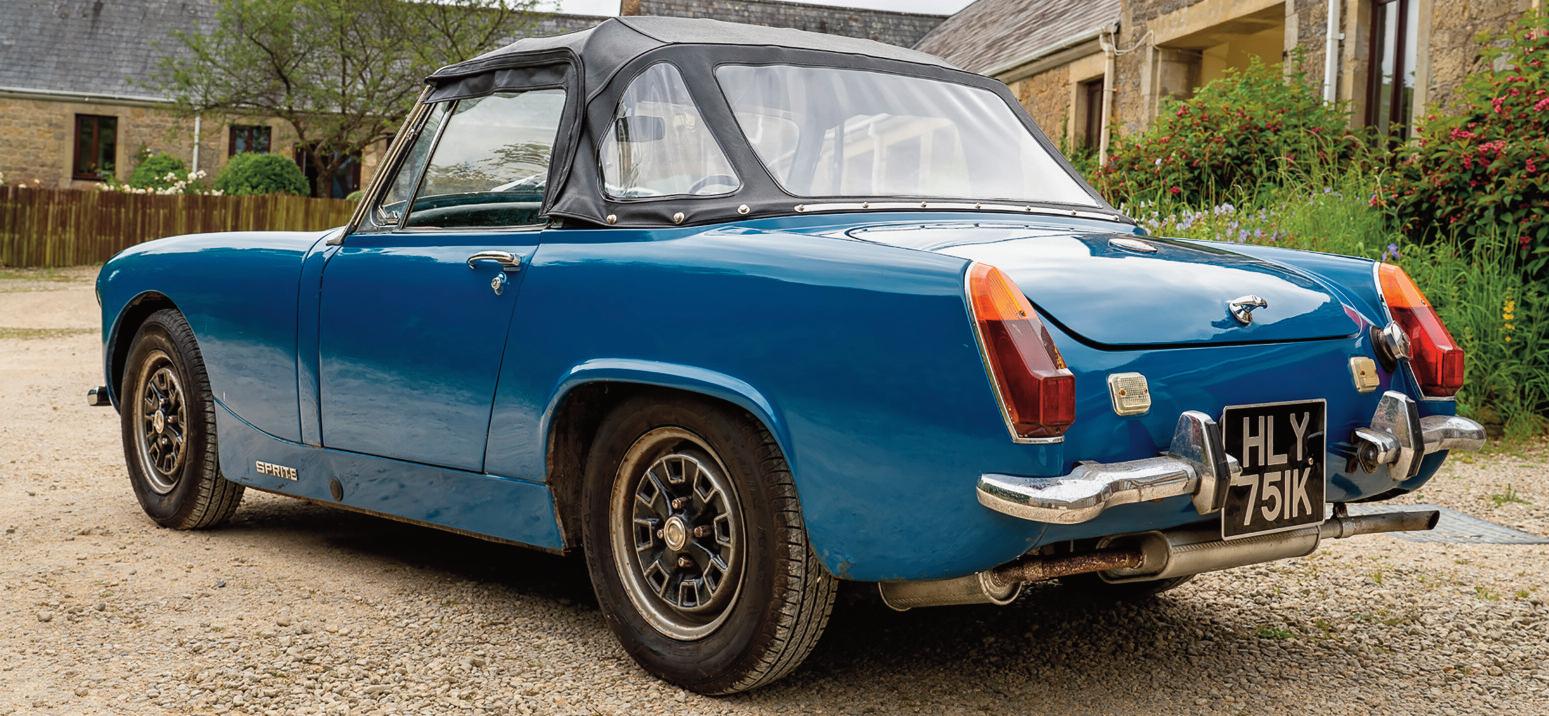
● Older conversion to 924 Carrera GT specification
● 200bhp+ track day weapon with classic Porsche looks

In 1979 Porsche submitted a styling exercise to the Frankfurt Motor Show to introduce ideas that shaped the look of the forthcoming 944 The following year, the company entered the 924 at Le Mans, and needed to homologate a race car to meet Group 4 racing regulations The homologation version was called the 924 Carrera GT, a developed 924 Turbo incorporating wider front and rear wings similar to those seen on the well-received styling exercise.
Porsche made 406 of the 924 Carrera GTs in 1981, including six prototypes A step up from the GT was the GTS, of which 59 were made in the Stuttgart factory These are more powerful than the standard Carrera GT, thanks largely to increased boost. The GTS are distinguished by perspex headlamp covers replacing the pop-up headlights on the GT, and an intercooler in front of the engine rather than on top of it 15 of the 59 were Club Sport cars, featuring a roll cage, more power and less weight than the regular GTS In 1980 Porsche entered three 924 GTRs at the 24hrs of Le Mans, finishing 6th, 12th and 13th overall. Another notable GTR achievement was a class win at the 24 Hours of Le Mans in 1982

Registration Number: NWX 486V
Chassis Number: 93A0140530
Recorded Mileage: c.22,600 miles
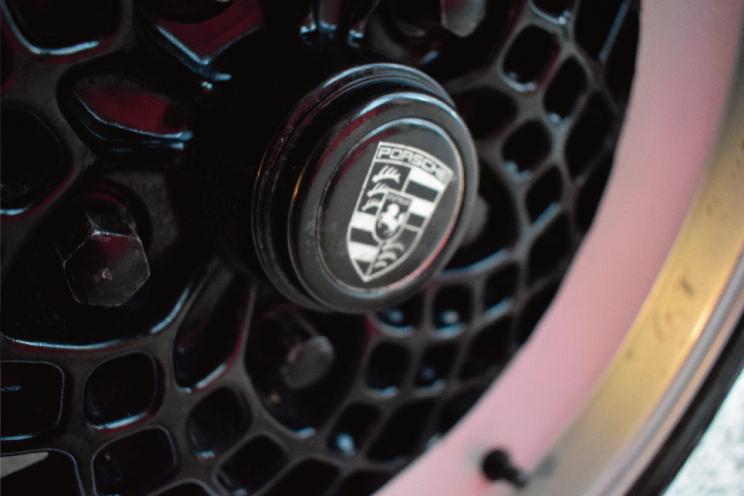

This purposeful-looking Porsche 924 Turbo was delivered in December 1979, finished in Grand Prix white with an oatmeal interior
The 924 was a few years later transformed into a Carrera GT replica, fitted with steel Carrera GT/944 front wings, rear wheelarch extensions, a lightweight double-skinned bonnet with CGT scoop, and fibreglass front bumper with the correct fog lamps and indicators
By then finished in Guards Red with correct Carrera GT decals, the 924 was acquired in this specification a number of years ago by our vendor for track day use
The 924 has been used for regular track days, being periodically improved during our vendor’s ownership
The Porsche runs a Devils Own water methanol injection system (with separate boost and air inlet temperature gauges) which boosts power to north of 200bhp, driven through a five-speed dogleg gearbox A three-inch stainless exhaust with a custom rear silencer improves breathing, sounds great and yet handily for track use produces no more than 95 decibels Turbo rear discs and drilled front discs with four-pot Brembo calipers ensure the car stops as well as it accelerates Revised suspension featuring adjustable Leda dampers, uprated springs and Fondmetal lattice wheels with Toyo Proxes TR1 tyres help keep the handling tidy
The interior of the car has been stripped out and fitted with period-correct Magnum lightweight bucket seats,
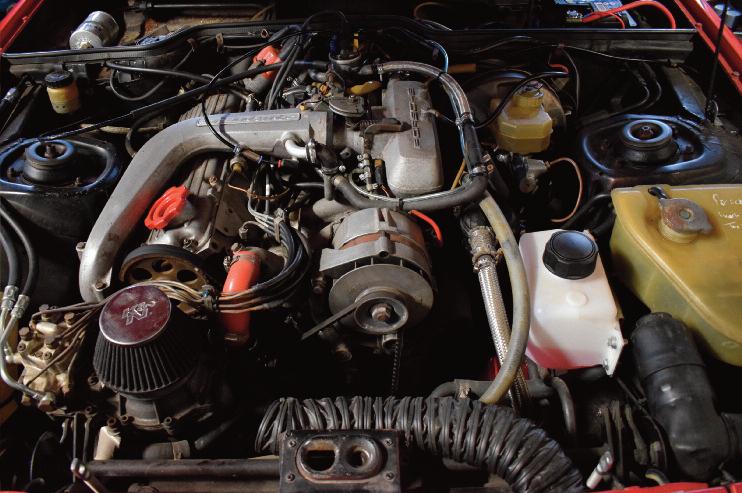

full race harnesses and a Momo suede steering wheel
A full 6-point roll cage by Roll Centre (with removable door bars) is an essential safety feature Recent work also includes a rebuilt (Turbo Technics) turbo charger, new shaft seals for the gearbox, numerous new water and fuel hoses, and additionally other items such as replacement WIR, AAR and Cold Start Injector.
Offered with a UK V5C document, a number of invoices, previous MoT certificates and also older photographs of the original conversion, this is a super cool looking classic track day car
£14000-£17000


● In current ownership since 2019
● Substantial history file

In October 1991, following a visit to the Tokyo Motor Show, Porsche began to devise solutions to succeed the poor selling 928 and incoming 968 (a heavy update of the 944) In February 1992, Porsche began development of a successor to the 928 (mildly updated for 1992) and recently released the 968 By June 1992, out of 4 proposals based on dual collaboration between the 986 and 996 (993’s successor) design teams, a proposal by Grant Larson and Pinky Lai inspired by the 356 Cabriolet, Speedster, and 550 Spyder was chosen by Harm Lagaay
Introduced in late 1996 and based on the 1993 Boxster Concept, the model was Porsche’s first road vehicle to

Registration Number: MF51 XBA
Chassis Number: WPOZZZ98ZZU641903
Recorded Mileage: 89,700 miles
be originally designed as a roadster since the 50’s 550 Spyder The name refers to the car’s “boxer” engine in combination with the name “speedster” as first seen on the 356. The 986 stimulated a commercial turnaround for Porsche, which during the early 1990s had been

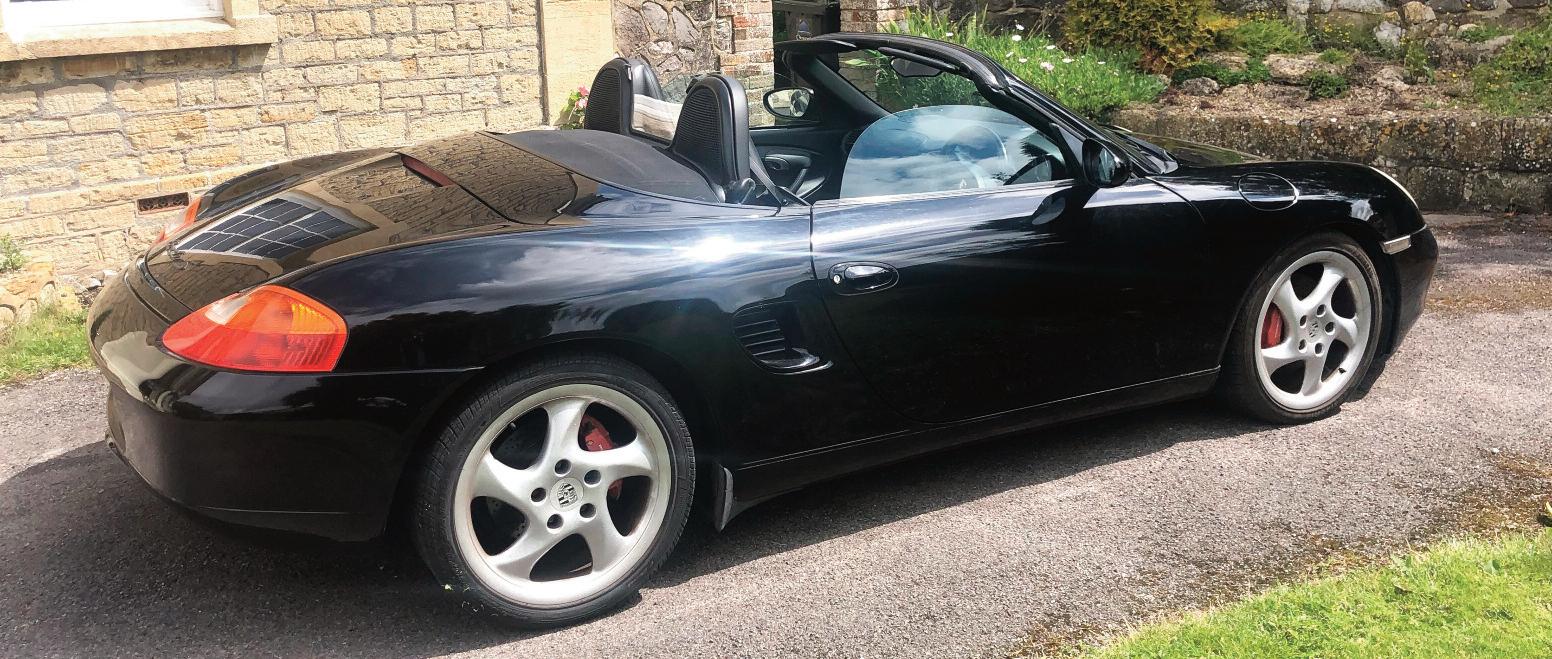
suffering with an ageing product range and falling sales, and it’s credited with saving the company The 986 Boxster was Porsche’s biggest volume seller from its introduction in 1996 until the introduction of the Cayenne in 2003.
Powered by a 2 5-litre flat six-cylinder engine, the base model was upgraded to a 2 7-litre engine in the year 2000 and a new Boxster S variant was introduced with a 3 2-litre engine In 2003, styling and engine output was upgraded on both variants The 986 was succeeded by the 987 which retained the Boxster roadster and added the Cayman fixed-roof coupé body style
Recognising that its customers wanted something more potent, Porsche introduced the S in 1999 alongside a new 2 7-litre base model The S came with a six-speed manual gearbox and a 250bhp 3 2-litre
engine that delivered 162mph flat out and 0-60mph in 5 9 seconds It cost £8000 more than the 220bhp 2 7 model but was still considerably cheaper than the 911 it was edging towards in performance terms Identifying marks on the S are its red-painted brake calipers, drilled brake discs, and white-faced instruments
This 2002 Boxster ‘S’ has been with the same local owner for the last 5 years, alongside one or two other classic cars The Boxster has been well maintained over the years, offered with several service stamps, plus various invoices and receipts in the factory book pack
Finished in Basalt Black with matching black leather trim and 18” Carrera wheels, this is a good looking entry sports car, offering bags of performance for a very sensible outlay
£4500-£5000

1983 Alfa-Romeo Alfetta 2 0
● In current ownership for 12 years
● Subject of sympathetic restoration in current ownership

In 1972, Alfa Romeo unveiled the Alfetta, a remarkably sophisticated, modern new saloon car with a transaxle layout, De Dion tube rear suspension and minimalistic styling courtesy of the brand’s Centro Stile The new model took the name Alfetta from the F1 World Champion winning cars of 1950 and 1951
The engine chose was the widely praised four-cylinder twin-cam, the gearbox placed in the rear together with the clutch, “De Dion” rear suspension with a “Watt’s” parallelogram linkage. The rear brake discs were placed “on-board”, to reduce the unsprung mass As such the Alfetta benefited from a perfectly balanced weight distribution, 50% on each axle The front had independent suspension with flexible torsion bar components and a rack steering system with adjustable steering wheel
In November 1981 the updated “Alfetta ‘82” range was launched, comprising 1 6, 1 8, 2 0 and 2 0 Turbo Diesel models All variants adopted the bodyshell and interior of the 2.0-litre models. All Alfettas had black plastic

Registration Number: ELP 985Y
Chassis Number: ZAR11656003011126
Recorded Mileage: 73,000 miles
rubbing strips, side sill mouldings, tail light surround and hubcaps; the 2000 sported a satin silver grille and a simulated mahogany steering wheel rim The Alfetta ran until 1984, being replaced by the new ‘90’ model
A rare example, this smart Alfetta was specified in Grigio Chiaro metallic silver with a Grigio Lava velour interior First
UK-registered in late 1982, selling to its first owner around 6 months later, the Alfa was discovered in longterm storage 12 years ago by our vendor, an Italian car enthusiast The car was in well preserved condition; there was no obvious corrosion though the paintwork had faded. The bodywork was stripped and refinished
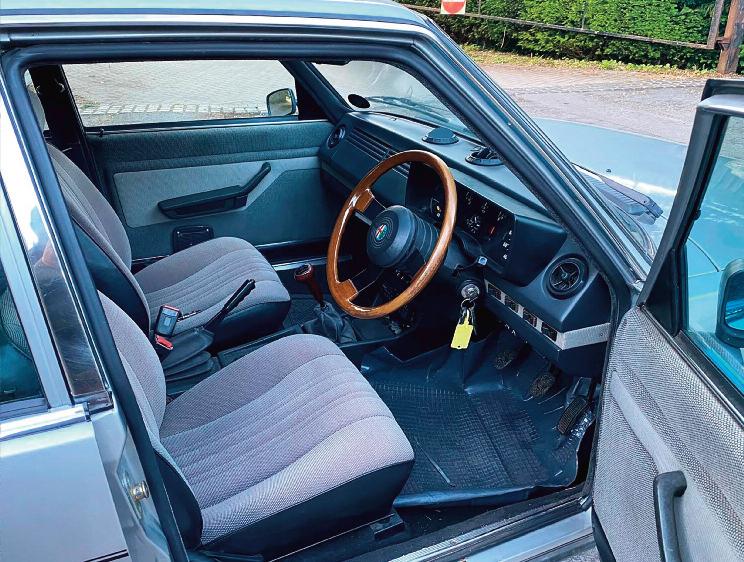

as original, the engine and carburettors removed, stripped and rebuilt, and refitted with new engine mounts. A power steering rack (from an Alfa 75) was fitted at the same time All suspension bushes and shock absorbers were replaced, and the front brake calipers rebuilt
The cooling system was overhauled with a new radiator, new hoses and thermostat. The alternator was overhauled, a full brand new exhaust fitted as were new/stock rear bumper number plate lights and all four bumper end caps sourced To complete the look a smart set of Campagnolo period alloy wheels were fitted.
With factory electric windows, a factory sunroof, central locking, also ULEZ, MOT and road tax exemptions, this is an eminently usable and economic classic Italian car which can be enjoyed every day The Alfetta shows c.73,000 miles recorded, and is offered with original build certificate, many receipts, original book pack, older MOT certificates, and V5C

Note: Having been garage kept recently the Alfa may require a small amount of recommisioning before being used regularly
£6000-£7000
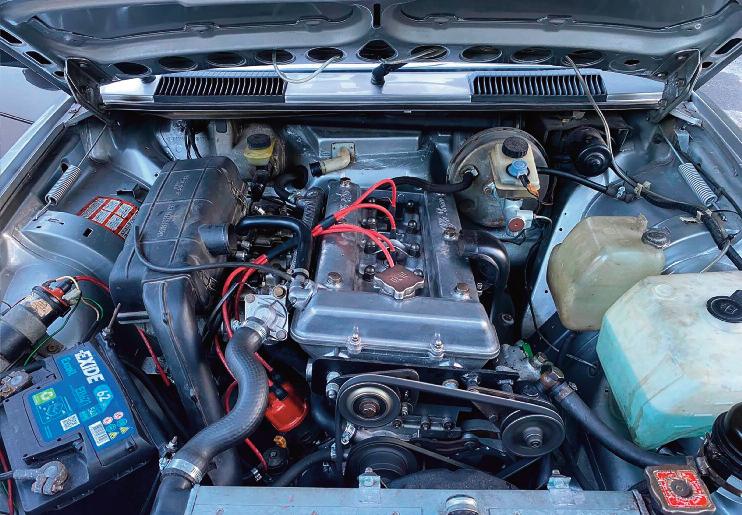

1975 BMW 2002tii
● Well historied example, subject to major older restoration
● Recent £12,000+ refurbishment
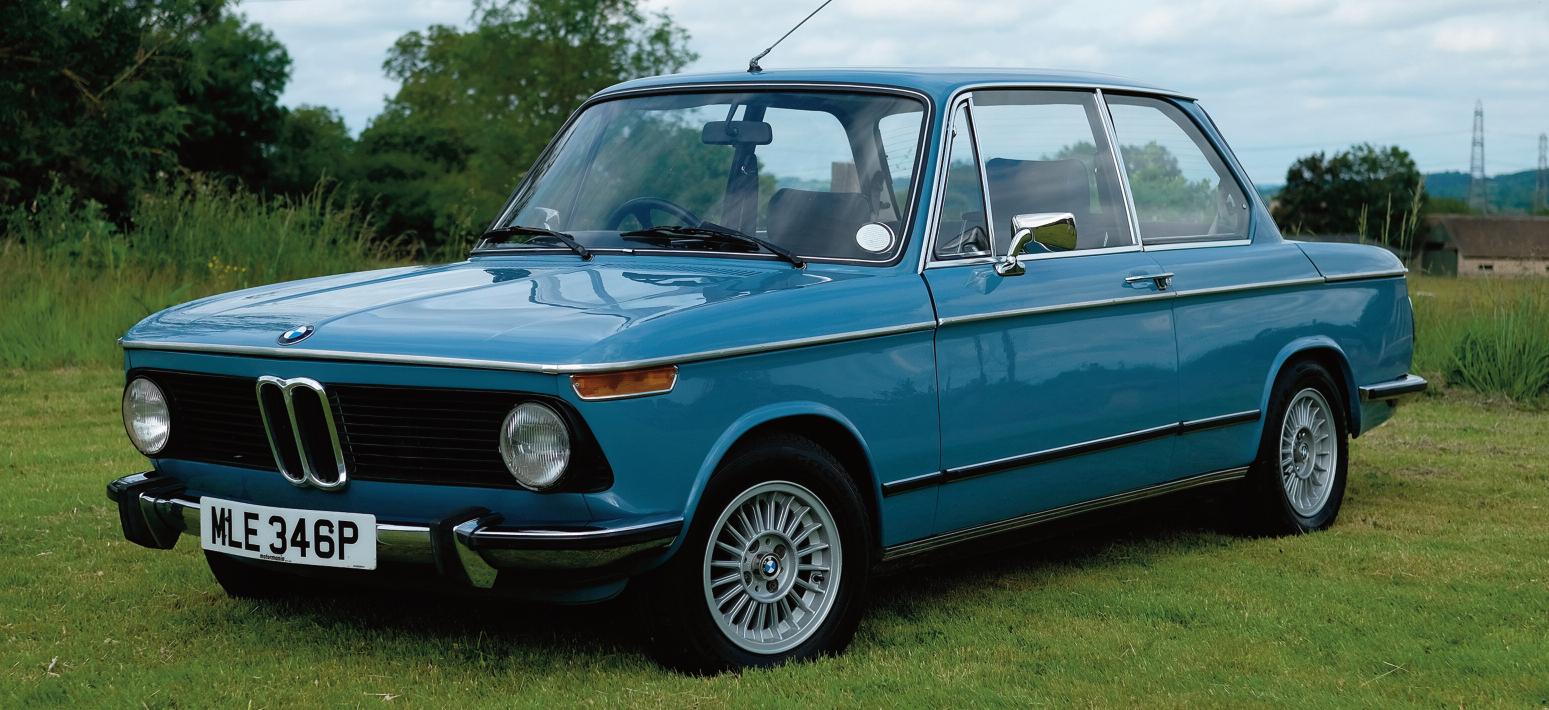
“It’s here at long-awaited last with all of the highpriced, understated functionality of a Hardy Amies hair shirt The BMW 2002 tii, exquisite penance for the unrehabilitated car addict ” Car and Driver, February 1972
With its lightweight body construction, four-wheel independent suspension, rear wheel drive and front disc brakes, the 2002 Tii provided lively performance with the practicality of a spacious cabin and large luggage area The BMW 2002 Tii is an icon in motoring history, one of the first truly exciting sports-orientated cars made by BMW
The Tii (Turismo Internazionale Injection) introduced fuel injection via a mechanical Kugelfischer system, superseding the former Ti’s carburettors and providing a significant performance boost With 130bhp sent to the rear wheels the car was thrilling to drive at the time, and is now an enduring favourite among enthusiasts and collectors. The model cemented its place in the history of the Bavarian marque, paving the way for the later 3-series and effectively creating the sporty, family saloon category that BMW went on to define
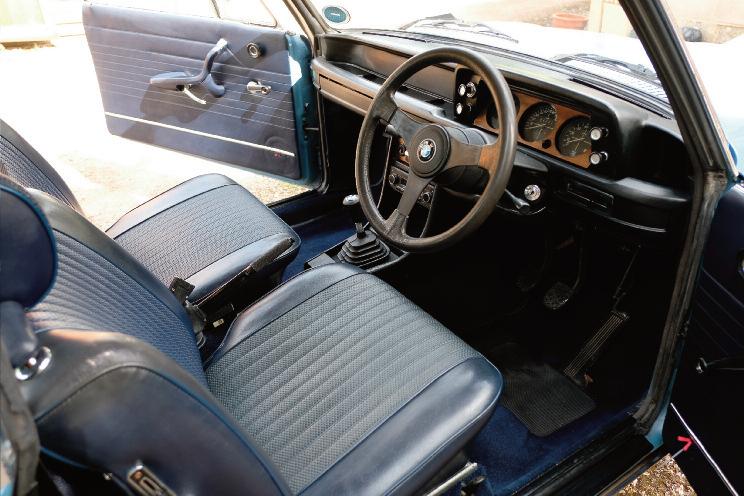
Registration Number: MLE 346P
Chassis Number: 2771204
Recorded Mileage: 62,100 miles



This particular Tii, a later facelifted 1975 model, is offered with an extensive history file of maintenance and restoration over the years. The BMW’s history file includes original factory manuals and stamped service books, also a large file of restoration receipts (mostly from 2009) to the tune of approximately £20,000 In recent ownership no expense has been spared to bring the 2002 to the condition as pictured here, supported by bills totalling a further c £12,000 The engine has been serviced, ball joints replaced, the brakes attended to, all underseal removed, any minor repairs undertaken, and then the floor areas refinished The whole underneath and cavity areas were then thoroughly rust-proofed
These efforts have produced a very attractive proposition for the next keeper, assuring many years of ownership without the headaches of rust treatment to
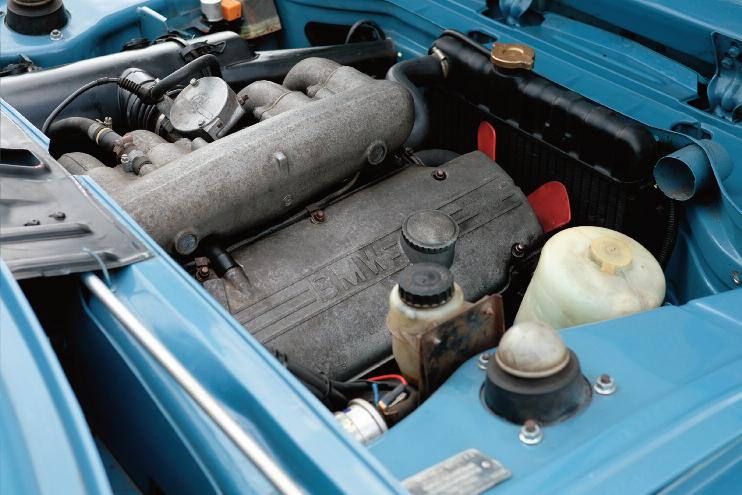

attend to. All works have been carried out with genuine parts, and by leading specialists on the O2 platform
The Tii now presents beautifully in its original shade of Riviera blue scheme with excellent brightwork, interior and engine bay Tasteful upgrades include a Turbospecification steering wheel, later (E30) five-speed gearbox conversion to make modern day driving a pleasure, also 13” period-correct Alpina-style wheels shod in period-correct Goodyear tyres
A turnkey car, this usable classic is the perfect addition to any collection and ready to enjoy right away A perfect blend of heritage, style, and driving pleasure and indeed the true embodiment of the Ultimate Driving Machine motto, the Tii is offered with a comprehensive history file and V5C
£25000-£30000
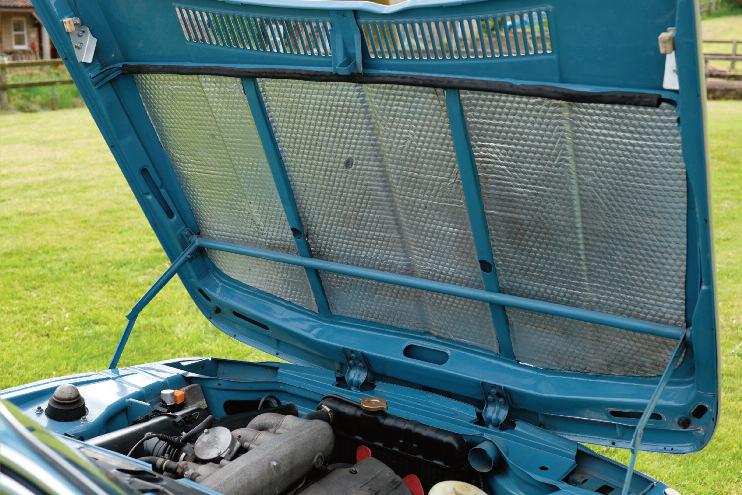
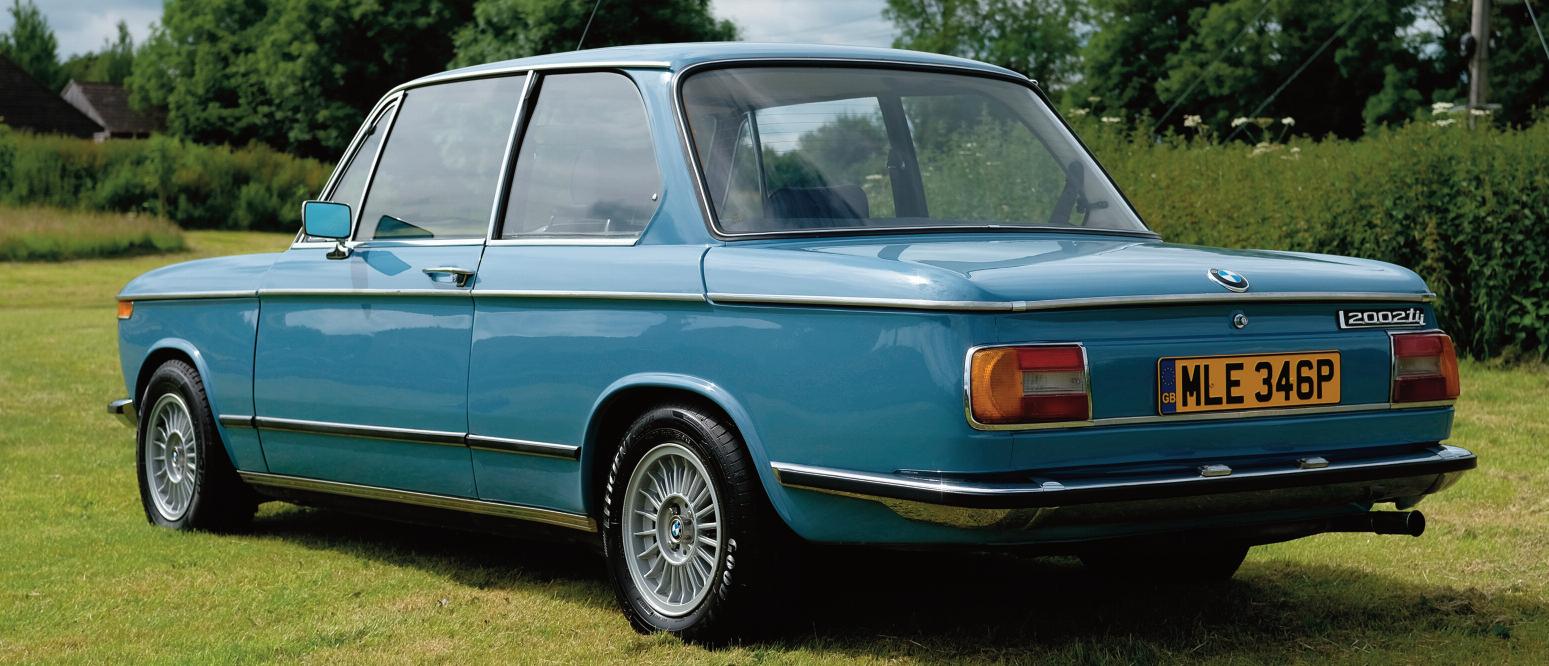
1968 Volvo 130 “Amazon” Saloon
● Single family ownership for 46 years
● Subject to sympathetic restoration in recent years

In 1956, a prototype of a new passenger car from Volvo was released. The car became known as the Amazon in Sweden and badged the 121 and 122S on the export market. Production began in 1957, the car was initially regarded as a larger model than the PV444 The fact that the 121/122 S was a 4-door model naturally contributed to this The styling was modern, this model was the first car from Volvo with a pontoon body The Amazon 121/122 S also had a very high safety level with features including a padded upper half of the dashboard, a laminated windscreen and seat belt attachments both front and rear
In September 1961, yet another version based on the 121/122S was presented, a two door saloon. The two door version was somewhat lighter; it was also regarded as a sportier version and therefore used in competitions, both within the rallying and motor racing

Registration Number: JTK 231G
Chassis Number: 5213
Recorded Mileage: c.56,500 miles
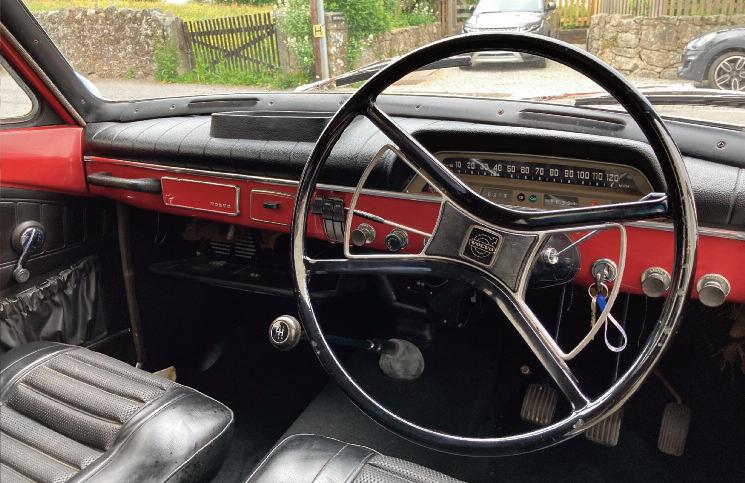


fraternity To enhance the sporty image of the Amazon, the fast and lavishly equipped 123GT version was introduced in 1966, with the same engine as the 1800S sports car In 1968, another larger engine version was added to this model, the so-called 2 0 B20 engine
Production of the P130 continued until July 2nd 1970
Purchased new in 1968 from Volvo agent Parkway of Dorchester, this UK/RHD Amazon stayed with the same family for a further 46 years Always dry stored, the Volvo was garaged off the road from the 1990s until more recently being sympathetically restored The car’s coachwork was deemed sound, only requiring a replacement outrigger and wheel arch, before being refinished in several coats of its original Cherry Red (46) shade At the same time the engine was removed, checked, converted to unleaded, given a clean bill of health and refitted, and an overdrive unit fitted to the gearbox The interior is original with the exception of the dashtop and the addition of carpets, so we cleaned and refitted
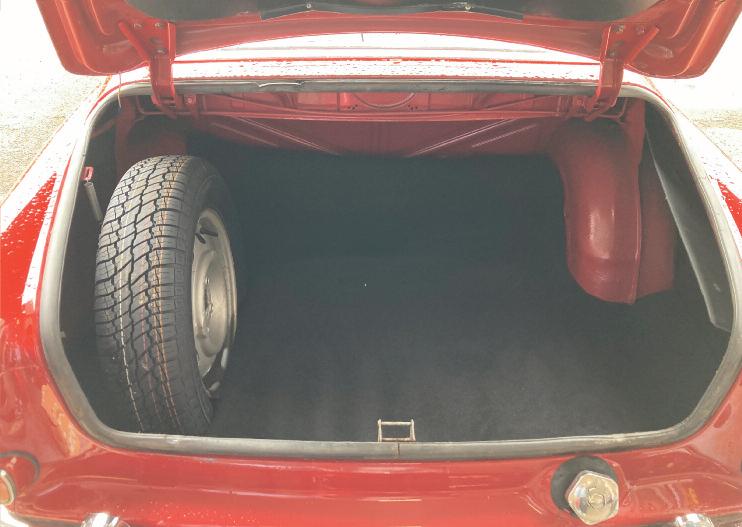
Complete with a comprehensive history file containing the original bill of sale and a number of older MOT certificates, this is a very genuine example of one of the most stylish and fuss-free everyday classics you can buy
£9000-£11000

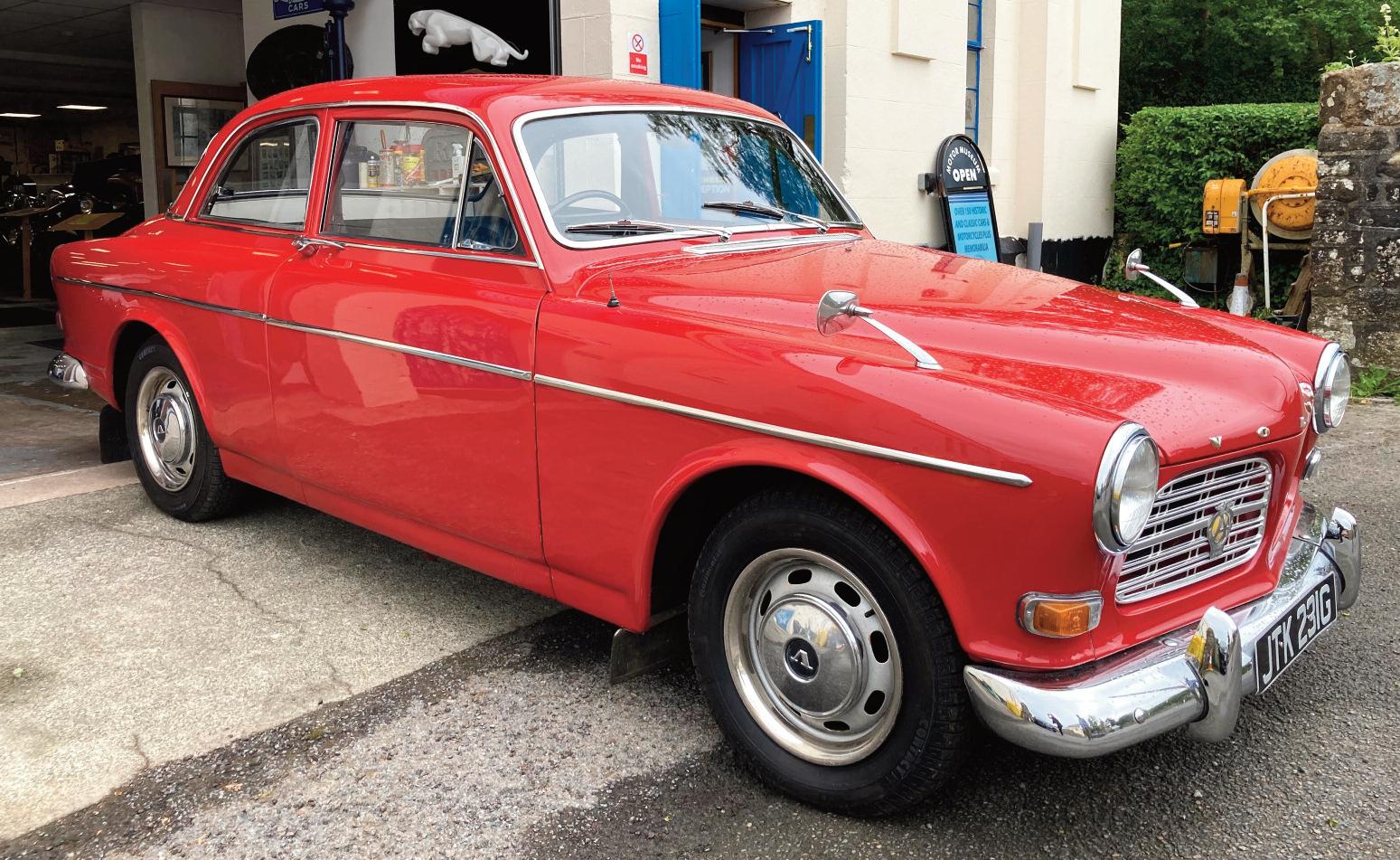
● In current ownership since 2003
● Prolific record of historic rallying
● Invoices totalling £40,000+ in restoration and and rally preparation

“Two-Carburetter High-Compression Version of the Wolseley 1500 Provides Outstanding Speed and Acceleration Combined with Good Handling Qualities and High Gear Ratios” , Bill Boddy, Motorsport Magazine, February 1958.
Although not intended as a competition car, thanks to its lightweight construction and good turn of speed, the new
One-Point-Five became an effective weapon in rallying and racing In December 1957 a team of three cars were prepared by BMC’s Competitions Department, in addition to those being worked on by private enthusiasts, with admittedly varying levels of success The three works cars built in the winter of 1957/58 made their competition debut at the Monte Carlo Rally of 1958. Unfortunately, they, along with most of the other entrants, failed to finish
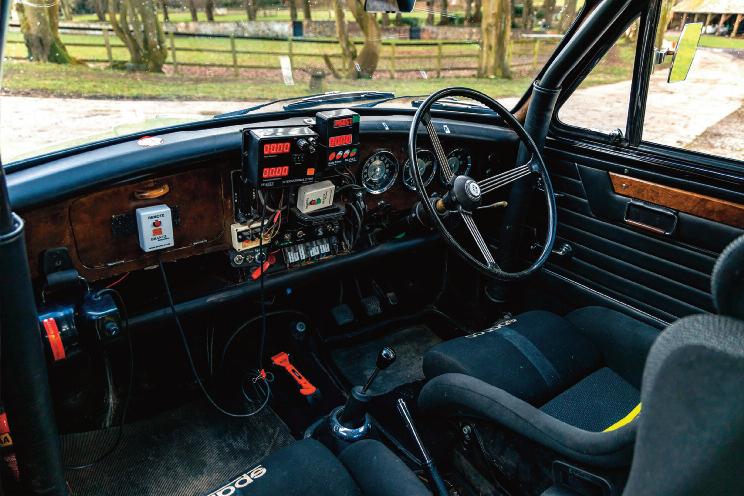
Registration Number: 709 AXH
Chassis Number: R-HSR1-19600
Recorded Mileage: 18,000 miles (unwarranted)
The 1 5 however was successful in the new British Touring Car Championship between 1958 and 1963, debuting in 1958 at Brands Hatch, where Harold Grace scored an impressive second in class 1958 also saw Jack Sears and Tommy Sopwith finish level on points, requiring a tie-break to achieve this Sears beat Sopwith by four seconds in the second race, taking the duel and the title by 1 6 seconds, thereby becoming the first BSCC champion.
First road-registered in May 1960, this charming OnePoint-Five has had just four owners from new, the first until 1998. In current ownership now for over 20 years,


the Riley was converted to FIVA historic rally specification in the early 2000
Previously maintained by specialist Richard Thorne Classic Cars, from 2006 care was transferred to Chris Snowden Racing At this time a full restoration was commissioned, replacement of some body panels/doors, engine rebuild, a bare metal repaint, undersealing and Dinitrol protection to the sills.
Previously painted grey, the Riley is now refinished in two-tone light yellow and black, the cabin being trimmed in black vinyl with front Sparco racing seats and black Sabelt harnesses In 2014 the engine was rebuilt once more; in 2016 preparation work was passed to renowned Riley specialist Peter Banham Motorsport, who have looked after “Elsie” to the present day
The car is fitted with a roll cage and a Marshall mechanical fire system, and while the rear seats and dashboard remain in situ, the dashboard has been fitted
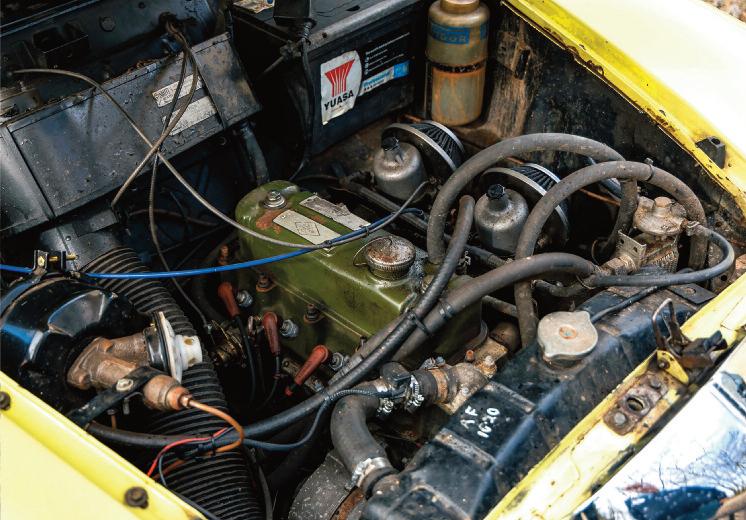


with a selection of timers, exposed fuses, toggle switches, and a battery cut-off switch The standard road wheels have been replaced by 14” Minilites shod with Yokohama Wdrive V903 tyres
Affectionately named ‘Elsie’, this plucky One-Point-FIve has competed in numerous rally events including the Rally of the Tests (14 times), Three Castles, The Summer Trial, The Winter Trial, and also a number of one-day events, The Riley has finished every rally it has been entered into, the last being in November 2021 A simple, straightforward and super reliable car, this 1960 model is eligible to be entered competitively in a number of historic rallying events.
“Elsie” is offered with a large selection of spare parts, FIVA identity card, FIA papers (expired), a comprehensive file of maintenance invoices, and a number of older MOT test certificates
£8000-£10000
